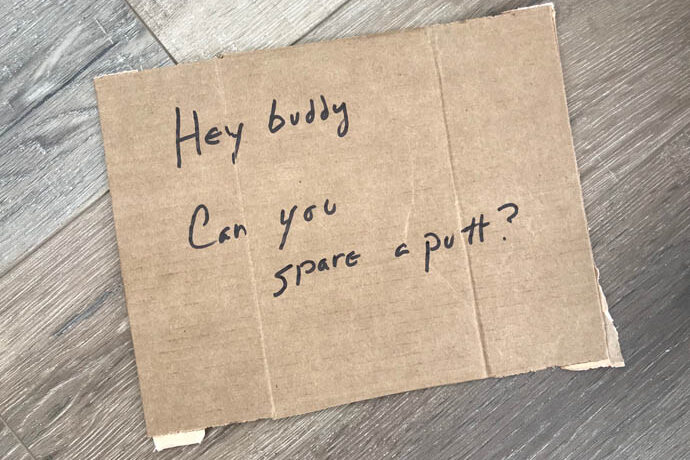Devices to help you make more putts
If you’ve been struggling with putting, this article is for you. It contains reviews of several putting aids that can help you or someone on your holiday shopping list make more putts.
First, some background. For years, I was the worst putter I knew (and I may still be). I thought I’d hit rock bottom when I set a personal record by three-putting nine greens in a round a few years back. But after sporadic periods of acceptable putting, my new personal worst for 3-putts now stands at a jaw-dropping 12.
I’d gone to the claw grip and back again. The only thing I haven’t tried is the long putter, which I;ve resisted because, well, I don’t want to spring for a long putter just to see it leaning against the wall of the garage after a month or two.
Plus, having once interviewed a guy who had 21 putters, I’m petty sure it isn’t the putter’s fault.
Missing the short ones
The killer was that I was missing really short putts, just outside the gimme range.
How bad was my putting? Gregg Dewalt, editor of Alabama Golf News, who played for the University of North Alabama and is an excellent putter, once gave me a four-footer to save me the ignominy of a five-putt six at an especially gnarly par 3 at Streamsong in Florida.
Gregg suggested I was peeking on short putts – moving and coming out of the putt prior to impact. I tried working on that but was still missing.
Obviously, an intervention was needed, so it was time to bring on the putting aids.
I went shopping and there are thousands of putting aids on the market. I narrowed it down and came up with three affordable gadgets, all with good reputations, all available at GolfTrainingAids.com, which seems to be the center of the Internet universe for putting aids.
The three putting aids I chose were the venerable Putting Arc, Dave Pelz’s O-Balls, and the Putting Connection Deux. All focus on grooving your stroke in different ways. All three aids are under $50 on the GolfTrainingAids.com website. I tried them all.
Putting aids and back to putting 101
To start things off, I went to my instructor, Monty Mills, a former GolfTec instructor in Albuquerque where I live. I’ve hit rock bottom. Get me back to the basics, back to ground zero, I said. He agreed and stood back to watch me putt. We weren’t three minutes into our session before he announced that I was setting up with my putter face closed.
No way! He held the grip of my Ping ½ Wack-e mallet putter as I stepped out of my stance to see for myself. What I thought was square wasn’t.
We then went on to the overall setup: Eyes over and slightly behind the ball, locked wrists, arms hanging straight down, elbows tucked into the ribs to promote a shoulders-rocking stroke – as opposed to the swinging elephant trunk stroke I’d made in the past – where my arms moved but my shoulder stayed level through the stroke,
Once I got back to the basics, I took the three putting aids to the practice green at my local muni.
Dave Pelz O-Balls, 3-pack, $19.99
The Dave Pelz O-Balls are regulation golf balls with two thick red alignment stripes, sort of like tire tracks, circling the ball. On the sides are two Os, where the axles would be.
 They’re pretty straightforward. Find a straight putt, align the stripes to the line of your putt, then make a stroke. When properly aligned to the hole, the stripes also provide a visual cue to squaring the putter face.
They’re pretty straightforward. Find a straight putt, align the stripes to the line of your putt, then make a stroke. When properly aligned to the hole, the stripes also provide a visual cue to squaring the putter face.
A stroke that strikes the ball squarely sends it rolling with the alignment stripes staying on line. A glancing stroke with an open or closed face sends the ball toward the hole with the alignment stripes spinning cockeyed.
The feedback is immediate. Whether you’re an arc putter or a pendulum putter, a square strike sends the ball down the line, its stripes spinning smoothly – like a gyroscope.
A downside
The only problem: Getting the stripes aligned. Lining them up with the line of the putt can be a tedious exercise in fiddling with the ball. I’d seen this on the course – watching guys who use Callaway striped balls or Taylormade’s Response striped balls repeatedly setting and resetting their balls.
After about 40 minutes of using the O-Ball, I realized I’d spent about half that time in a crouch aligning the balls, not actually putting them. Not an efficient way to practice, I thought. But the O-Ball does what its maker claims, which is tell you when your stroke is square and when it’s not.
The Putting Arc T3, $39.99
 The Putting Arc has been around since 2002 since its invention by PGA Instructor V.J. Trolio and engineers Joey Hamilton and Dave Hamilton. At first, I thought it was pricey for a piece of yellow plastic, but it’s actually quite cool in its simplicity.
The Putting Arc has been around since 2002 since its invention by PGA Instructor V.J. Trolio and engineers Joey Hamilton and Dave Hamilton. At first, I thought it was pricey for a piece of yellow plastic, but it’s actually quite cool in its simplicity.
At first glance, it looks like a straight 20-inch piece of plastic, but a closer look shows the edge curves in a slight arc which acts as a guide for your putter to follow on both on the back stroke and through stroke.
The Putting Arc is now an entire family of devices, some bigger, some smaller (like the T3 I tried). They even make an inexpensive plastic guide attachment for the neck of a putter like the Odyssey two-ball putter, which doesn’t have the kind of heel needed to follow the Putting Arc.
I can see why the Putting Arc has been a smashing success. You align it anywhere from five to 10 feet from the hole. You anchor it to the green by sticking tees through two guide holes, which prevents it from moving. Then you stroke your putts with the heel of your putter sliding along the arc. Make a smooth stroke following the arc and the ball goes in the hole.
 From five feet, I was a putting machine. At 10 feet, I made most of my putts, but at 20 feet, I found my stroke got a little loose and my make percentage went way down.
From five feet, I was a putting machine. At 10 feet, I made most of my putts, but at 20 feet, I found my stroke got a little loose and my make percentage went way down.
Importantly, the Putting Arc showed me that the extra length of my stroke at 20 feet had me closing down the face slightly at impact, which led to pulled putts and a different sound as the putter interacted with the Putting Arc’s surface on follow-through.
The Putting Arc is a winner, in my mind, because you can make a stroke while using it as a guide, then immediately drop a ball a few inches away from it and make a stroke without the guide to reinforce the feeling of making a good stroke. This is a gift any golfer would love to have.
Putting Connection Deux, $29.99
 Boy, I wish I had stumbled across this little gem during my days of disconnected loose-elephant-trunk putting, back when I’d make a stroke but my shoulders didn’t rock. (Accuracy of line was good; distance control sucked.)
Boy, I wish I had stumbled across this little gem during my days of disconnected loose-elephant-trunk putting, back when I’d make a stroke but my shoulders didn’t rock. (Accuracy of line was good; distance control sucked.)
The Putting Connection Deux is simply an adjustable plastic bar with two C-shaped ends. You hold the device against the insides of your elbows, assume your stance and make a stroke.
The length of the connecting bar can be adjusted to fit it to your build and stance. It’s a little awkward to get positioned correctly while gripping your putter. But once in place, the Putting Connection Deux guarantees that your arms move in concert with your shoulders and not separately. It also promotes locked wrists.
 A bonus of the device is that by taking practice strokes without a ball you can see what the natural arc of your stroke looks like. Its makers also tout the Deux as a chipping aid.
A bonus of the device is that by taking practice strokes without a ball you can see what the natural arc of your stroke looks like. Its makers also tout the Deux as a chipping aid.
If there’s a downside to the device, it comes with no direction on how to use it and the YouTube video accompanying the product description on the GolfPuttingAids.com site is all of four seconds long, meaning you’re watching the next YouTube offering before you can digest what you just saw.
Empire 4004 48-inch heavy-gauge aluminum ruler, $13.97
 Finally, I’m including in this review of putting aids something my instructor, Monty Mills, turned me on to – an inexpensive and ingenious aid available at Home Depot. I’ve used it by itself and in conjunction with the two of the products reviewed here.
Finally, I’m including in this review of putting aids something my instructor, Monty Mills, turned me on to – an inexpensive and ingenious aid available at Home Depot. I’ve used it by itself and in conjunction with the two of the products reviewed here.
The key to using this four-foot-long heavy-gauge ruler as a putting aid is the hole at the end of the 2-inch-wide ruler. Find a straight putt and align the ruler on the green. Place the ball on top of the hole, aim down the ruler and try to keep the ball from rolling off one side or the other before it reaches the end of the ruler. Plus, the ruler’s butt end acts as a visual cue as to whether your putter face is square at address.
You can use the ruler at home on the living room carpet or on the putting green. On a straight 20-foot putt, if the ball stays on the ruler until the end it will likely go in the hole. You get immediate feedback on your stroke. For me, it further confirmed my tendency to come outside-in and pull my putts.
“Use it for 20 to 30 putts a day at home and I guarantee you you’ll putt better,” Monty said.
Dan Vukelich is the online editor of Alabama Golf News. He lives in Albuquerque, N.M.
Have a story idea or a news item to report to Alabama Golf News? Email gregg@alabamagolfnews.com
Featured image by Dan Vukelich







